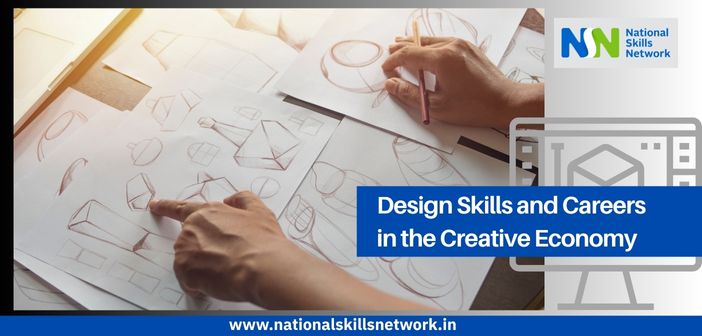India’s creative economy is steadily becoming a major contributor to innovation, employment, and cultural identity. With design and creativity driving transformation across sectors such as crafts, education, and technology, this growing ecosystem offers immense potential for sustainable growth and entrepreneurship. The focus now lies on empowering people with creative skills, design thinking, and innovation for inclusive and culturally rooted development.
In this conversation with Dr. Madhuri Dubey, Founder-Director, National Skills Network and Mr. Philip Thomas, Country Head, World Design Council; the discussion highlights the broader meaning of the creative economy, the role of design in local and cultural development, the importance of creativity in education, and how skills and ethical technology use can shape sustainable careers.
Below are a few excerpts from our conversation. You can watch the full video on our YouTube channel.
Q: What is the creative economy?
A: The creative economy is much broader than what is commonly seen as the creative industries like film or media. It stands on four key pillars; creativity, knowledge, intellectual property (IP), and job creation. Together, they contribute to economic growth, export earnings, social inclusion, and cultural diversity. Globally, almost 10% of GDP is expected to come from creative content, and for India, this can mean new opportunities for both urban and rural economies. Creative work, when combined with design and innovation, can create jobs, boost entrepreneurship, and support local economic development.
Q: Why does design matter for the creative economy?
A: Design plays a central role in linking creativity to business, livelihoods, and innovation. It gives structure and value to creative ideas and helps transform traditional skills into marketable products. For example, when artisans apply design knowledge to their craft, they create products that connect better with consumers and attract new markets. Design also drives innovation across industries and acts as a tool for preserving and promoting India’s cultural identity.
Q: How can the creative economy drive local livelihoods?
A: India’s vast network of handloom and handicraft clusters shows how creativity and design can support rural livelihoods. Empowering artisans with design skills allows them to adapt traditional crafts to modern markets and earn better incomes. A strong example comes from the pottery community that revived its craft through design training, leading to large-scale installations in corporate campuses and public spaces. Such design-led interventions help artisans sustain their heritage while improving their standard of living.
Q: What policy changes would help the creative economy?
A: There is a need for a comprehensive Creative Economy Policy that brings together sectors such as design, AVGC, film, and crafts under one framework. At present, each sector works independently. A unified policy would encourage collaboration, enable intellectual property development, support creative entrepreneurship, and strengthen the link between creativity, culture, and tourism. It would also align creative industries with the Sustainable Development Goals (SDGs) and make India’s creative sector globally competitive.
Q: How should design in education evolve to meet industry needs?
A: Design in education should move beyond theory and classroom projects to real-world engagement. Students need to work directly with artisans, local communities, and enterprises to understand how design impacts livelihoods. Hands-on learning, research-driven projects encourage empathy, storytelling, and innovation; all vital for a designer today. Institutions must also invest in R&D and technology integration to prepare students for emerging roles in the global design ecosystem.
Q: How can schools promote creativity and design thinking?
A: Creativity and innovation must be nurtured from an early age. The Future Creative Minds (FCM) program by the World Design Council introduces design thinking and innovation in schools from grade 6 onwards. It trains teachers to become facilitators who guide students through hands-on learning. This early exposure helps children develop curiosity, problem-solving skills, and confidence to adapt in an uncertain, technology-driven future.

Q: What opportunities exist in the AVGC sector?
A: The AVGC sector in India is moving from an outsourcing model to one focused on original content creation. Several states have introduced dedicated AVGC policies, grants, and incubation facilities. There’s a growing ecosystem of startups and investors supporting homegrown games, animation, and digital content. With proper policy support and skill development, this sector can generate large-scale employment and global recognition for Indian creators.
Q: How can creators shift from outsourcing to IP creation?
A: Building intellectual property is the key to sustaining the creative economy. Indian studios are now developing proprietary tools, games, and software using emerging technologies. By creating original IPs rooted in India’s stories and culture, creators can expand beyond domestic markets and gain international visibility. The goal is to move from being service providers to becoming producers of globally competitive creative content.
Q: What skills are essential for young creative professionals?
A: Foundational creative and design skills are more important than ever. Mastering storytelling, visual expression, and design principles helps professionals use technology effectively. Tools like AI can simplify tasks, but creativity, originality, and a deep understanding of the craft are what sustain careers. Technology should complement human creativity, not replace it. AI must be used responsibly to protect original creators and cultural integrity. It should serve as a tool to enhance creativity rather than replicate or exploit existing work. Establishing ethical guidelines and frameworks for AI use will ensure that creative professionals retain ownership and recognition for their ideas, while still benefiting from technological innovation.
Also read: How to Become a Successful Content Creator
Q: What lies ahead for India’s creative economy?
A: The next few years hold great promise as design-led education, early creative skill-building, and policy support come together. The focus should remain on empowering students, artisans, and professionals to use creativity as a tool for sustainable livelihoods. With the right ecosystem, India can emerge as a global leader in design, innovation, and cultural entrepreneurship.
















